Thesis
Digital content consumption continues to surge, riding the wave of increasing internet penetration and evolving consumer behavior following the COVID-19 pandemic. 63% of the world's population was using the internet as of 2021, up from 54% pre-pandemic in 2019. Moreover, 92% of consumers who tried online shopping in 2019 became converts and continue to access twice the number of businesses online than before the pandemic. Within this landscape, the creator economy, buoyed by over 200 million digital content creators, is valued at $250 billion today and is growing. These creators range from social media influencers and bloggers to artists and educators, all harnessing digital platforms to reach audiences directly. The emergence of the creator economy signifies a shift from traditional media, reflecting consumer appetite for more personalized, authentic content.
However, the growing creator economy faces challenges. The average person had 8.6 social media accounts in 2020, up from 4.8 in 2014. The fragmented digital landscape means that audiences are often siloed within platforms, making it difficult for creators to reach an audience scattered across multiple social media platforms. As these platforms have grown, they have built walls around their ecosystems. Instagram downranks content reposted from TikTok, and Twitter has begun marking Substack links as unsafe, limiting creators' ability to effectively reach their followers across various platforms. Active attempts to reinforce walled gardens limit creators' reach and ability to interact effectively with their audiences across platforms.
Linktree is a platform that allows creators to consolidate their online presence into a single link that they can share across different social media platforms. By helping creators bundle their social media experience, Linktree makes it easier for audiences to engage with a creator’s content across various platforms. In breaking down the silos between different platforms, Linktree aims to help creators manage their digital presence and broaden their audience reach.
Founding Story

Source: Index Ventures
Australia-based Linktree was founded in 2016 by Alex Zaccaria (CEO), Nick Humphreys (Chief Creative Officer), and Anthony Zaccaria.
Prior to founding Linktree, the Zaccaria brothers and their friend, Humphreys, ran Bolster, a digital agency specializing in music and entertainment, for 8 years. Bolster worked with festivals, labels, artists, events, and brands to help them grow their audiences. Its work on band management and event planning involve frequently using Instagram as a promotional platform. Like many users, Zaccaria was frustrated with the constraint of Instagram's single bio link when trying to direct followers to multiple pieces of content, such as a band's latest song, concert tickets, or merchandise.
To overcome those limitations, the trio launched Linktree in 2016. It was conceived as a tool that would let people and companies gather links on a single webpage. The team developed the first iteration of Linktree in under 6 hours with the help of a developer they commissioned. Leveraging their network of major artists and music festivals, they sent the initial version of the Linktree product to their contacts in the music industry. Starting with a high-profile userbase enabled them to gain early adopters and clients quickly.
A notable early inflection point came when Alicia Keys, the renowned singer, signed up for Linktree after a passionate user uploaded Linktree to Product Hunt. Linktree climbed the ranks of Product Hunt overnight, with over 3K users signing up and marking the start of Linktree’s growth.
Product
Linktree offers a link-in-bio platform that acts as a customizable, mobile-optimized micro-website, enabling users to centralize their online presence into a single navigable page. A user’s Linktree page can be accessed via a single link that users place inside their social media bios.

Source: Linktree
Free
The Free plan is a basic tool that offers users unlimited links and customizable features for their Linktree page, allowing them to centralize their digital presence effectively. It is ideal for users who wish to experiment with the concept of a single-link bio without any financial commitment. This plan bridges the gap between multiple platforms and provides a simple, streamlined method for followers or customers to navigate various digital content.
Features include:
Links & buttons: Unlimited links, media app integrations (SoundCloud, Spotify, Apple Podcasts), and basic embedded media (Pinterest, Twitter, Twitch, Facebook, YouTube).
Analytics: 28 days of history.
Monetization: Payments support (PayPal, Square), e-commerce store integrations (Shopify, Spring, Bonfire), and donations support.
Customization: Free themes with limited ability to customize Linktree profile and page.
Management: 48-hour support response times, multi-factor authentication, and access to the mobile app.
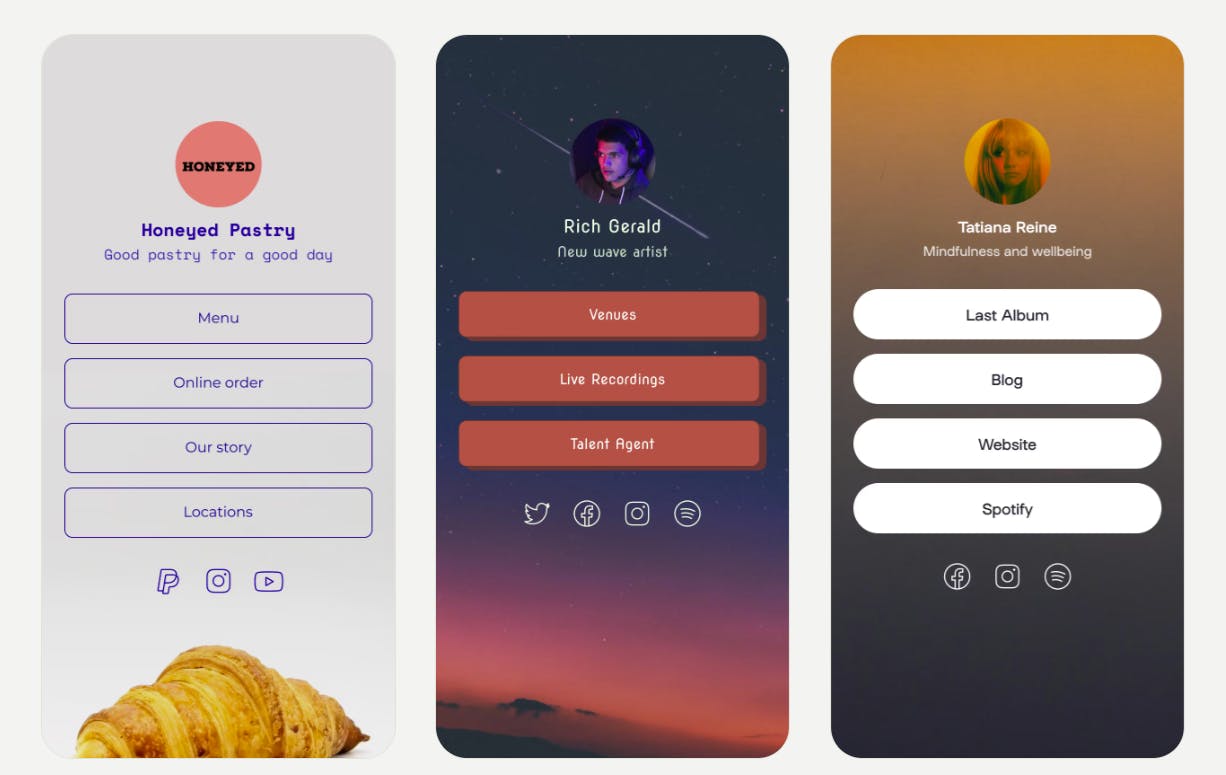
Source: Linktree
Starter
The Starter plan gives creators more control and customization, enabling them to direct more traffic through their digital hub. It includes additional themes, custom link thumbnails, social icons, and priority support. This plan targets individuals or small businesses that want to enhance their online presence and drive more engagement with their audience.
Features include:
Links & buttons: Advanced link options like animated, spotlighted, and scheduled links.
Analytics: 90 days of history and detailed link analytics (referrer, location, commerce, and social media).
Monetization: Affiliate program support enables users to earn commission from traffic and purchases made using their links.
Customization: Full customization options, including button and font styles, premium Linktree themes, and custom background images/videos.
Management: 24-hour support response times
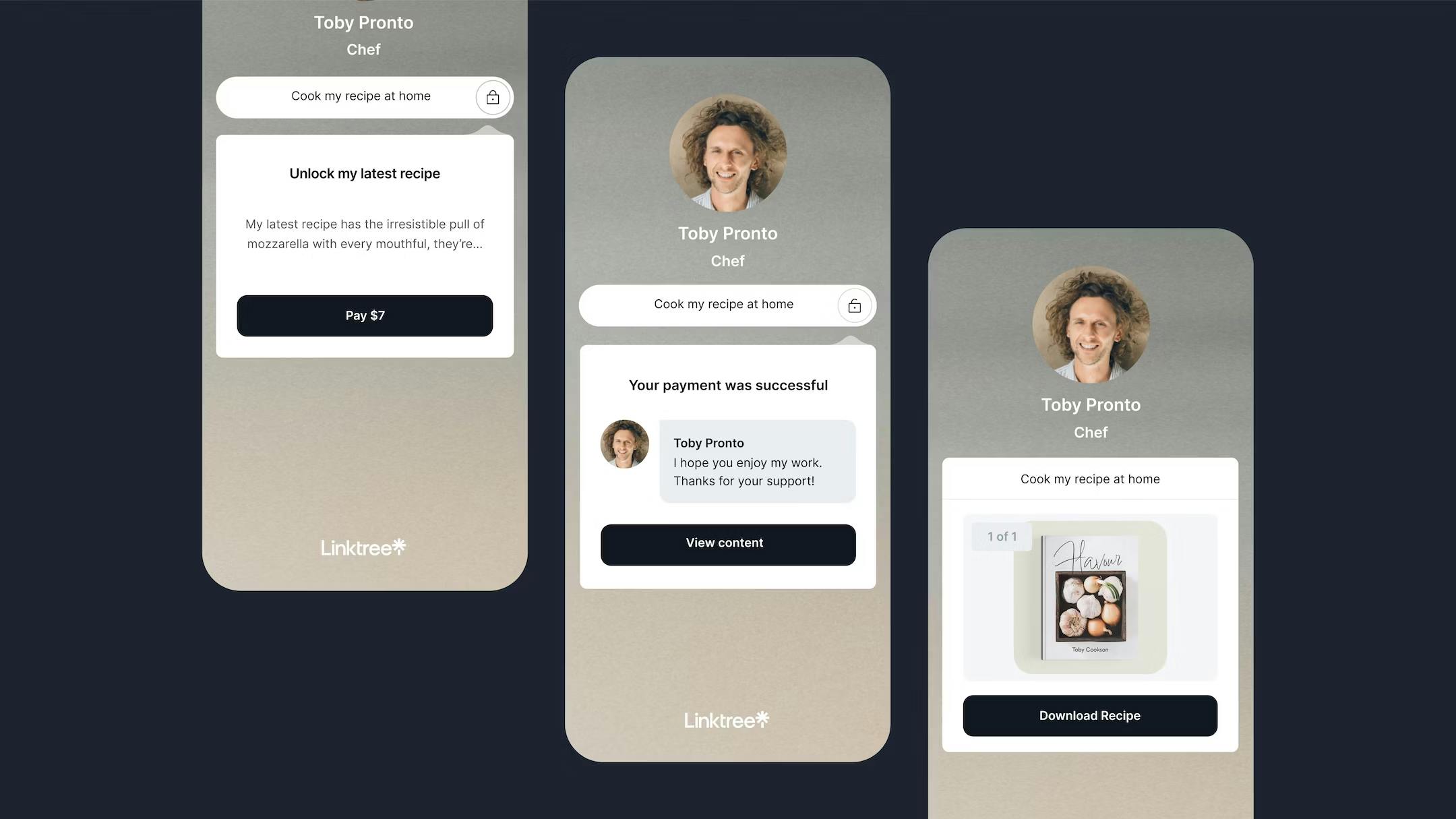
Source: Linktree
Pro
The Pro plan allows users to learn about and grow their social media followings with detailed analytics and marketing tools. It includes location-based analytics, gathering contact info, and email and SMS marketing integration. This plan is for professional creators, influencers, and businesses that aim to maximize their online presence, reach, and monetization opportunities.
Features include:
Links & buttons: Visitor data collection (email, phone number), embedded media (YouTube videos, Tweets, RSS feed), mobile app link promotion, code-restricted links
Analytics: 1 year of history, conversion tracking, detailed link analytics (social, commerce, email and phone number, streaming service).
Customization: Removal of Linkedtree branding on a user’s page.
Marketing tech: Advanced tools for tracking visitors and driving link conversions like Google Analytics support, SEO optimizations, and exporting email lists to MailChimp.

Source: Linktree
Premium
VIP support and advanced features tailored to businesses ready to monetize and sell on a larger scale are offered in the Premium plan. It incorporates every feature from lower-tier plans and adds the ability to export data, providing a comprehensive toolset for large-scale operations.
Features include:
Analytics: Lifetime history and the ability to export data.
Management: 4-hour support response times, a dedicated customer success manager, and personalized onboarding calls.
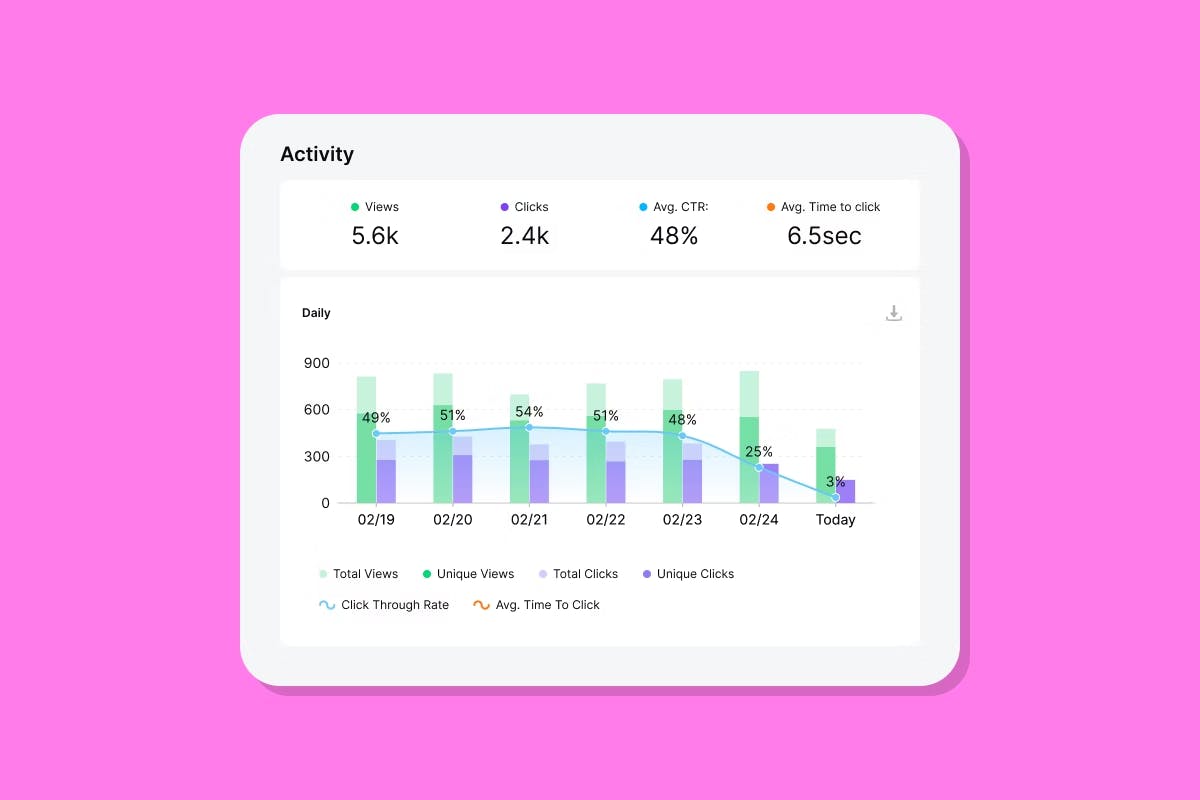
Source: Linktree
Marketplace
Linktree Marketplace is a hub where creators can discover and access tools and integrations that can be included in their Linktree page to amplify their online presence. With 39 apps and six integrations spanning categories like media, ecommerce, fundraising, and payments, users can offer services directly from their Linktree page. These integrations allow users to enable visitors to interact with content, services, or platforms without redirecting them to an external website or app.
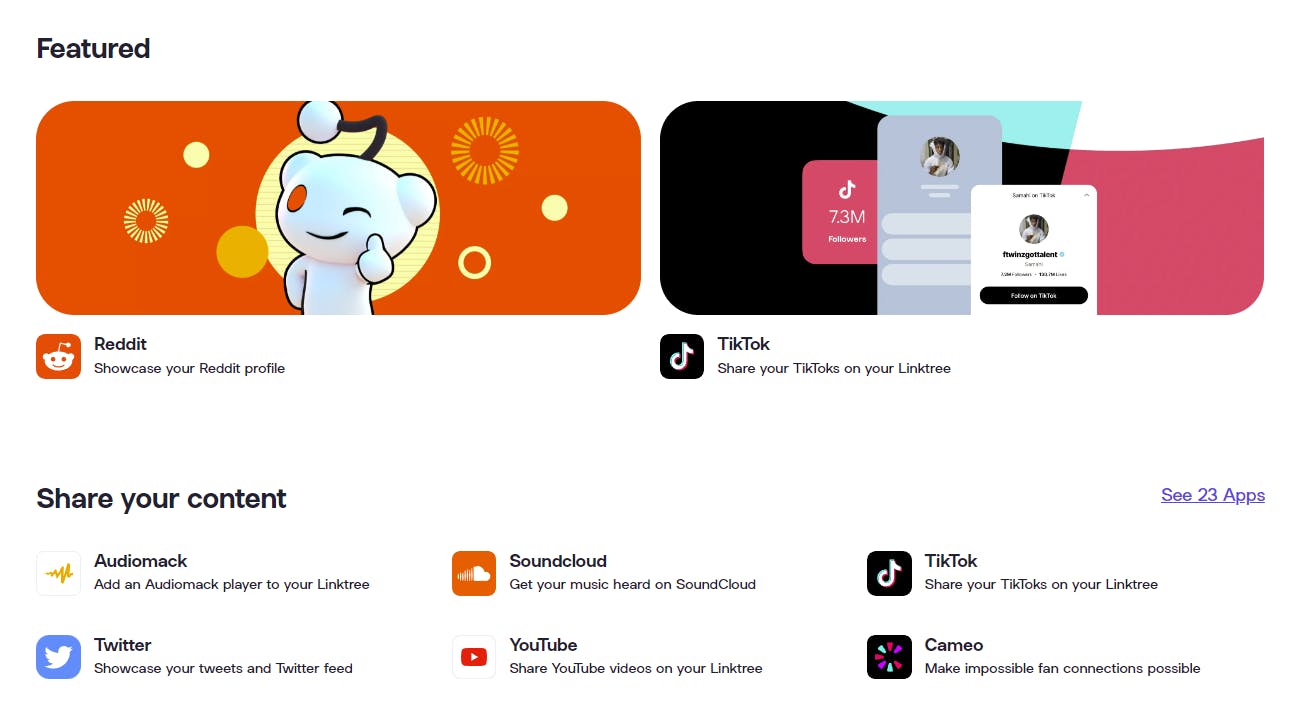
Source: Linktree
Market
Customer
Linktree's customer profile spans two categories: digital creators and businesses. Creators use Linktree to consolidate their online presence into a single, accessible location. These include influencers, musicians, athletes, and other creators using various online platforms to share content and interact with their audiences. They leverage Linktree to funnel followers from their social media bios to a curated list of other online platforms, products, or services. Linktree bridges the creator's content and their audience's access to it, encouraging higher engagement and facilitating easier monetization.

Source: Linktree
For businesses, Linktree acts as a mobile-friendly digital storefront. These range from small businesses to large companies aiming to simplify the user journey to desired content or products. Businesses utilize Linktree to guide their customers from social media platforms to specific sections of their websites, promotional campaigns, or ecommerce platforms.
Market Size
The global market size for link-in-bio platforms, such as Linktree, is nested within the broader social media management software market, which was valued at $15.2 billion in 2021. This market is growing at a CAGR of 22.8% and is expected to reach $118 billion in 2031. Key growth drivers in this sector include the expanding role of social media in brand and influencer marketing and the rising need for tools that simplify social media content management and enhance audience engagement.
Facing intense competition, many link-in-bio platforms have expanded into offering their users direct selling and e-commerce features to offer differentiated services. Global trends towards increasing digital content consumption and online shopping present growth opportunities for Linktree, emphasizing the importance of link-in-bio platforms for complementing creators and social media platforms.
Competition
Koji: Koji, a link-in-bio platform similar to Linktree, provides users with an interface to share multiple links and social media profiles and monetize with digital products. It allows users to customize their pages with interactive features, making it a direct competitor to Linktree. Koji's extensive customization options and interactive capabilities may attract users looking for a more engaging link-in-bio solution. Koji has raised $36 million in funding to date. As of January 2022, over 150K creators had used Koji to engage with their audiences. Creators can use Koji landing pages to receive tips or charge fans for extra videos or custom video messages. It typically charges between 5%-15% of fan purchases.
Beacons: Beacons is another link-in-bio platform offering features similar to Linktree, such as multiple link aggregation and page customization. Beacons focuses on offering e-commerce capabilities, enabling users to sell digital products directly from their pages. It has raised $6.2 million in total funding. Beacons generate revenue through monetization-focused blocks, including a feed with shopping capabilities, a digital storefront for videos, and a "requests" block for creators to sell custom content to their followers. It charges a 9% fee on transactions on its free plan, and the premium plan reduces that to 5%.
Squarespace: While primarily known for its user-friendly, customizable design templates, which allow users to create polished websites, Squarespace acquired Unfold in 2019, which like Linktree is a link-in-bio platform. In 2021, Squarespace launched Biosites, a personalized, single-page website specifically aimed at the link-in-bio space.
Shopify: Known for its e-commerce platform, Shopify launched its link-in-bio offering in 2022. Branded as Linkpop, this offering targets customers seeking to sell products directly from a link inside their bio. Linkpop users can leverage sales analytics and tools developed by Shopify and features like print-on-demand and dropshipping. Creators and merchants can add vital information to their pages and launch storefronts on Linkpop, enabling their followers to purchase their products without leaving the app. Merchants can easily create an account, link it to their Shopify store, and add up to 200 clickable links to their Linkpop — links such as webpages, articles, videos, playlists, etc. These shoppable links are automatically linked to merchants’ product catalogs, displaying the necessary product details for customers before they purchase.
Business Model
Linktree operates on a tiered subscription business model with four plans: Free, Starter, Pro, and Premium.
Free ($0 monthly): This tier allows users unlimited links and a customizable Linktree to connect their community to all their content. This plan caters to individuals and small creators looking for a simple way to share their online presence.
Starter ($5 monthly): This tier offers enhanced customization options and control for creators aiming to drive more traffic to their links. It is tailored towards creators seeing an increase in their online following and needs more tools to manage their growing presence.
Pro ($9 monthly): This tier helps creators grow their following while offering branded customization, providing more in-depth analytics and adding advanced features like link scheduling. It caters to well-established creators who want to enhance their brand presence further and gain deeper insights into their audience behavior.
Premium ($24 monthly): This tier is designed for businesses ready to monetize and sell at a larger scale. It offers VIP support and e-commerce integration capabilities, enabling businesses to connect and transact with their community directly through Linktree.

Source: Linktree
Its pricing tiers allow Linktree to serve a broad spectrum of users, from individual content creators to larger businesses, while generating recurring revenue from paid subscriptions. Customers also have the option to subscribe to a plan on an annual basis at a discounted rate.
Traction
Linktree has seen early traction, gaining 3 million users in its first three years. As of June 2023, Linktree had over 35 million users worldwide. It reported $25 million in revenue in 2022, off the heels of a 17% reduction in force in August 2022. Linktree also reported $50 million in losses in 2022. In June 2023, Linktree announced layoffs of an additional 27% of its workforce, primarily impacting Australia and New Zealand-based roles, stating a desire to focus team growth in the United States.
The platform has also built partnerships to expand its offerings. Notable collaborations include TikTok, GoFundMe, and Amazon, offering integrations to users' profiles. Major social media accounts like Selena Gomez, Katy Perry, Red Bull, and the LA Clippers use the platform to direct audiences to their multiple online locations.
The platform is in the top 400 most popular websites worldwide as of June 2023 and reported 1.2 billion unique visitors a month in March 2022. The initial success of Linktree has kick-started a niche segment of social media management software, referred to as link-in-bio platforms.
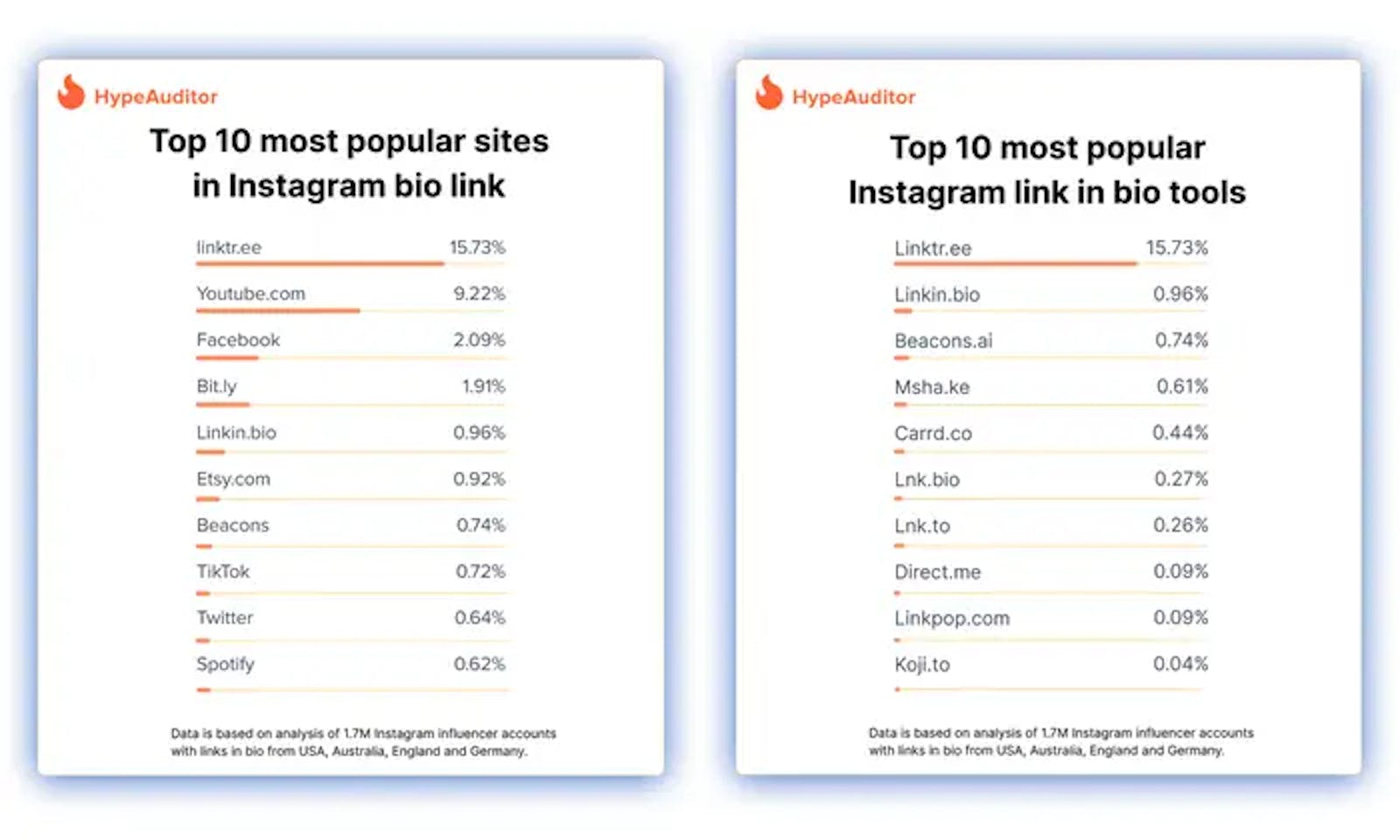
Source: Business Insider
Valuation
In March 2022, Linktree announced a $110 million Series B round led by Index Ventures and Coatue, valuing the link-in-bio platform at $1.3 billion. The company has raised a total of $165 million from investors, including Insight Partners and AirTree Ventures. It reported $25 million in revenue in 2022. As of June 2023, Linktree had over 35 million users worldwide. That indicates Linktree earned less than $1 in revenue per user and a revenue multiple of 52x at its 2022 valuation.
Key Opportunities
Advertising
Linktree has an opportunity to expand its business model by implementing advertising. With millions of users, the platform presents an untapped market for targeted, in-line advertising. Social media platforms like Facebook and Instagram embed ads within user feeds and show how advertising is a proven monetization path for social media platforms. Linktree could offer a similar service for its users. Companies could pay to have their links appear in the Linktree profiles of users that match their target demographic, creating a new advertising channel.
Moreover, these ads could be tailored to individual user interests based on the links they include in their profiles, providing a high degree of personalization. By introducing this advertising model, Linktree could create a new revenue stream and increase the value proposition for businesses and influencers using the platform. However, advertising could disrupt Linktree’s ad-free simplicity and straightforwardness, alienating existing users.
Expanded App Integrations
Embracing expanded integrations with popular platforms could open significant opportunities for Linktree. Linktree supports 39 linked apps and six integrations as of June 2023. Integrating with additional apps, such as creator platforms like Patreon and Substack, would allow creators to link their subscription-based content directly, making it easier for supporters to access exclusive content and for creators to grow their followings. A Discord integration could be beneficial for communities to stay connected, particularly for influencers, gamers, and clubs who wish to engage their audience in real-time discussions.
On the B2B side, integrating with applications like SeatGeek could help organizations promote their events and sell tickets directly, simplifying the customer journey. These expanded app integrations could increase the value proposition of Linktree and make the core link-in-bio platform harder to duplicate. Linktree's position as the go-to platform for consolidating an individual's or brand's online presence would be strengthened and user stickiness to the platform could be increased.
Key Risks
Platform Dependency
Linktree's business model relies on major social media platforms' policies, practices, and longevity. The primary function of link-in-bio platforms is to enable users to share multiple links within their social media profiles, particularly those with single-link restrictions. However, this reliance presents a significant risk. Changes to policies or algorithms by these social media platforms can negatively impact Linktree's visibility and utility.
For instance, if a major platform were to ban Linktree links due to policy changes, as Instagram did briefly in 2018, the user base and, subsequently, Linktree’s revenue could decline significantly. Other examples include Twitter temporarily announcing a policy banning links promoting other social networks in December 2022, including Linktree, although this policy was quickly rescinded. Moreover, any reduction in the popularity of these platforms could also affect Linktree's growth and sustainability. As Linktree's success is tied to the continuity and rules of other platforms over which it has no control, platform dependence remains a substantial risk to its business model.
Competition
Linktree's simplicity, while a key selling point for users, exposes the company to the risk of being easily copied by competitors. Its business model primarily provides a single page that hosts multiple outbound links for content creators, influencers, and brands. However, this straightforward service presents a low entry barrier for competitors. Social media platforms such as Instagram have already introduced similar features, posing a potentially significant threat to Linktree's user base and revenue.

Source: TechCrunch
Furthermore, new entrants offering similar services have also emerged, with more than ten companies launching link-in-bio tools since 2020. While Linktree has a first-mover advantage and significant brand recognition, the ease of replicating its core offering can potentially lead to a loss in market share. This risk is amplified by the low user switching costs in this segment, and there are no network effects to increase Linktree’s stickiness. If competitors can offer additional benefits, such as lowered cost, integrated analytics, or monetization options, they could lure away Linktree’s users.
Monetization
The long-term viability of Linktree’s freemium model is uncertain and poses risks to the business. While Linktree’s free tier has successfully driven user growth, transitioning these users to paid plans may be challenging. Linktree reported just $25 million in revenue in 2022 from over 35 million users, indicating the company makes less than $1 in revenue per user. An industry figure commenting on Linktree’s revenue noted it was “Well below benchmarks across almost any measure of efficiency,” with the startup counting $50 million in losses in 2022.
At this point, is unclear whether the value proposition of Linktree’s core product is compelling enough to convert enough free users to paid plans to operate a long-term, profitable business. Efforts to generate revenue through additional methods, such as advertisements or partnerships, could alienate its user base if not carefully managed, with users sensitive to intrusive or irrelevant ads. The inability to successfully and sustainably monetize remains a significant risk to Linktree’s success.
Summary
Linktree operates in the growing link-in-bio space, providing users with a platform to consolidate their online presence into a single, clickable link. The application is designed to solve the problem of managing multiple digital touchpoints by providing a straightforward way to connect audiences to various platforms or pieces of content. Its relevance is heightened in today's internet age, where content creators, influencers, businesses, and individuals maintain presences across multiple platforms and formats.
However, Linktree faces stiff competition in a market populated by social media giants and emerging startups offering similar capabilities — offering a basic link-in-bio service is no longer enough. Additionally, it needs to contend with the risk of platform dependency, especially given the evolving policies of major social media sites. To navigate these challenges, Linktree must continue innovating and delivering unique value to its users while maintaining its simplicity and user-friendly approach. As the platform evolves, strategic partnerships, user acquisition, and engagement initiatives could help fortify its position in the market. Overall, Linktree's future success is contingent on its ability to adapt to the rapidly changing digital landscape and maintain its relevance in an increasingly crowded space.

